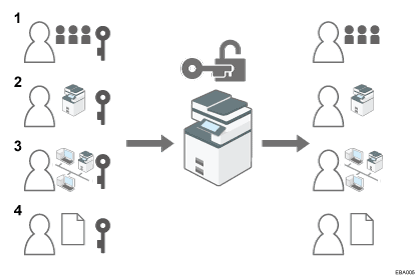Configuring Administrator Authentication
Administrator authentication requires the login user name and password for verifying administrators attempting to specify the machine's settings or access them from a network. When registering an administrator, you cannot use a login user name already registered in the Address Book. Administrators are managed differently from the users registered in the Address Book. Windows authentication and LDAP authentication are not performed for an administrator, so an administrator can log in even if the server is unreachable due to a network problem. Each administrator is identified by a login user name. One person can act as more than one type of administrator if multiple administrator privileges are granted to a single login user name. For instructions on registering the administrator, see Registering and Changing Administrators.
You can specify the login user name and password, and encryption password for each administrator. The encryption password is used for encrypting data transmitted via SNMPv3. It is also used by applications such as Device Manager NX that use SNMPv3. Administrators can only manage the machine's settings and control user access, so they cannot use functions such as copying and printing. To use these functions, the administrator must register as a user in the Address Book, and then be authenticated as the user. Specify administrator authentication, and then specify user authentication. For details about specifying authentication, see Configuring User Authentication.
Roles of each administrator

User administrator
Manages personal information in the Address Book.
A user administrator can register/delete users in the Address Book or change users' personal information.
Users registered in the Address Book can also change and delete their own information.
If a user forgets his or her password, the user administrator can delete it and create a new one, allowing the user to access the machine again.
Machine administrator
Mainly manages the machine's default settings. You can set the machine so that the default for each function can only be specified by the machine administrator. By making this setting, you can prevent unauthorized users from changing the settings and allow the machine to be used securely by its users.
Network administrator
Manages the network settings. You can set the machine so that network settings such as the IP address and settings for sending and receiving e-mail can only be specified by the network administrator.
By making this setting, you can prevent unauthorized users from changing the settings and disabling the machine, and thus ensure correct network operation.
File administrator
Manages permission to access stored files. You can specify passwords to allow only registered users with permission to view and edit files stored in Document Server. Through this setting you can prevent data leaks and tampering due to unauthorized users viewing and using the stored data.
![]()
Administrator authentication can also be specified using a web browser from networked computers. (We use Web Image Monitor installed on this machine.). For details, see Web Image Monitor Help.
You can specify User Code Authentication without specifying administrator authentication.
